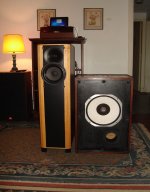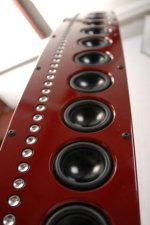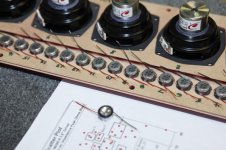Hi MarkHi, i built a pair of CBT's using 24 TC9's per speaker.
.............
Bingo ! 🙂 They look spectacular! It is great to have a direct opinion from a builder, confirming what the creators and other experts have said about the hearing sensation that the CBT system produces.
Thanks for the input, those TC9 are Peerless, right? They are 5 or 6 "Just out of curiosity.
P.S:
Troels DTQWTII achieves an excellent synergy in the coupling between the tweeter-waveguide/midwoofer. I have to put my ear directly on each transducer to perceive if it is radiating sound or is "out".
The FR integration on the axle is similar to the vintage JBL coaxial attachment.
Both constructions are my modest but at the same time best Diy achievements, 40 years have passed between both realizations.
And it shows in the sound, there is a big difference in the tonality / coloration / timbre of each one!
Whoever says that speakers have not evolved in all these years have not been able to make the comparison that you can see in the photo.
It is quite amazing.
Thanks again.
Rolo
Attachments
You bet Rolo 🙂
Glad that was along the lines of what you were looking for.
The TC9's are these...Peerless by Tymphany TC9FD18-08 3-1/2" Full Range Paper Cone Woofer
Madisound had them (pre covid) for under $9 when ordered in quantity.
Do check out the line array threads in the Full Range forum like folks suggested.
Lot's of guys have built them...often with this sweet little driver.
Glad that was along the lines of what you were looking for.
The TC9's are these...Peerless by Tymphany TC9FD18-08 3-1/2" Full Range Paper Cone Woofer
Madisound had them (pre covid) for under $9 when ordered in quantity.
Do check out the line array threads in the Full Range forum like folks suggested.
Lot's of guys have built them...often with this sweet little driver.
I glib quote by a publicist on the cover of a book can hardly encapsulate the nearly 500 pages of wisdom inside.Then you should actualy read it.
The front cover of the 3th edition has the spinorama of the JBL M2 on it, that speaker is alway's comming out on top in DBLT's (together with the Revel Salon 2). This is a constant directivity design.
I've followed the research of O'Toole and others on the perception of reproduced audio in rooms since the early 1980s and I have read his book from cover to cover more than once, as well as a lot of O'Toole's other published research. I do not see any conflict between O'Toole's findings and my comments. Perhaps I have failed to communicate clearly enough for the significance of my comments to be comprehended, comments which have their basis in physics not opinion.
The conundrum for loudspeaker design is to resolve the conflict between a desire for a linear transfer function (direct field) between the source and the listener, whilst creating a room response (indirect or total sound field transfer function) that supports realism.
In professional audio engineering from whence the term constant directivity derives, constant directivity systems intended designed to create a a linear transfer function over a specified angle between the source and listeners spread over a wide area of non-optimal listening positions within that design coverage, for applications in large venues where early reflections are minimal.
In a domestic sized room a true constant directivity loudspeaker design with a flat frequency response in the direct field to the listener will radiate too much energy in total at higher frequencies into the room and tend to make the room sound 'bright'. In real life additional acoustic absorption in the listening room can be used to compensate for the loudspeaker system, however then the room will tend to sound 'dull' for live acoustic sources in the room. That may or may not be important.
Last edited:
One could always cut the highs...
Concede the point about PA speakers voiced a certain way. Yet, other than their appalling appearance, which is not easily addressed, simply EQ-ing down the bright high end would make them much more listenable for the typical domestic setting. I know that "tone controls" are anathema to some, but is the purist approach (to design the ultimate passive crossover that will magically voice the speaker for all listening rooms) really the optimal choice? 😎
Concede the point about PA speakers voiced a certain way. Yet, other than their appalling appearance, which is not easily addressed, simply EQ-ing down the bright high end would make them much more listenable for the typical domestic setting. I know that "tone controls" are anathema to some, but is the purist approach (to design the ultimate passive crossover that will magically voice the speaker for all listening rooms) really the optimal choice? 😎
The conundrum for loudspeaker design is to resolve the conflict between a desire for a linear transfer function (direct field) between the source and the listener, whilst creating a room response (indirect or total sound field transfer function) that supports realism.
In professional audio engineering from whence the term constant directivity derives, constant directivity systems intended designed to create a a linear transfer function over a specified angle between the source and listeners spread over a wide area of non-optimal listening positions within that design coverage, for applications in large venues where early reflections are minimal.
In a domestic sized room a true constant directivity loudspeaker design with a flat frequency response in the direct field to the listener will radiate too much energy in total at higher frequencies into the room and tend to make the room sound 'bright'. In real life additional acoustic absorption in the listening room can be used to compensate for the loudspeaker system, however then the room will tend to sound 'dull' for live acoustic sources in the room. That may or may not be important.
This is absolutely exactly right. And in agreement with Toole's findings. And in agreement with my experience. You don't need any particular directivity, just that the power response needs to be smooth. If you have constant directivity and narrow dispersion, a lot of shelving is needed. Wide dispersion helps. And room absorption is also needed to absorb some of the power being radiated into the room. Thankfully, most rooms with regular furnishings do absorb more as the frequency increases.
You bet Rolo 🙂
Glad that was along the lines of what you were looking for.
The TC9's are these...Peerless by Tymphany TC9FD18-08 3-1/2" Full Range Paper Cone Woofer
Madisound had them (pre covid) for under $9 when ordered in quantity.
Do check out the line array threads in the Full Range forum like folks suggested.
Lot's of guys have built them...often with this sweet little driver.
As you suggest, I'll take a look at the full range section.
I opened the thread in this multi-way section, because the Keele link is a CBT system with 18 full range drivers and 72 tweeters, and the crossover is active with DSP.
Judging from the pictures, I could have sworn the full range speakers were bigger!
Your construction reduces costs, there is no xover, neither active nor passive, since those small 3 1/2 "drivers exceed 15 Khz, although you say you use EQ. Can you tell me why? It is necessary in a room with low reflections ?
Attachments
…perhaps the question was not understood:…There are several threads here at DiyAudio on the benefit of constant directivity - that is, keeping the same SPL over the entire audible frequency range over a wide spectrum, off-axis. …It is supposed to be a goal very pursued by audiophiles…Why does no one undertake such a project?
Because the desirable CD, that you mention as a goal of audiophiles, is most important in the horizontal, but the Keele CBT is only CD (or CBT) in the vertical.
yep, even though both vertical and horizontal contribute to DI. Axisymmetric horn would rule all axis but large ones are hard to manufacture and take lot of space. Small ones easy to manufacture and take less space, but control directivity only at higher frequencies. Combine with cardioid mid? Only thing left to disrupt directivity (assuming "perfect" horn and suitably perfect cardioid) is the xo, which shouldn't be too bad. Maybe a multiple entry horn? even more difficult to manufacture and may have ripple due to diffraction, but the constant directivity could be nice over wide bandwidth. CBT makes sense if you like the looks of it.
Last edited:
So when someone uses the acronym "CD" do they mean "constant directivity", which means uniform directivity ? ... or do they mean "controlled directivity", which is code word for a uniform but narrow directivity, i.e. horn / waveguide systems ?
...because I always thought "CD" as tossed about on this forum meant controlled directivity.
...because I always thought "CD" as tossed about on this forum meant controlled directivity.
For this thread I take the meaning as that defined in the first post.So when someone uses the acronym "CD" do they mean "constant directivity", which means uniform directivity ? ... or do they mean "controlled directivity", which is code word for a uniform but narrow directivity, i.e. horn / waveguide systems ?
...because I always thought "CD" as tossed about on this forum meant controlled directivity.
Your construction reduces costs, there is no xover, neither active nor passive, since those small 3 1/2 "drivers exceed 15 Khz, although you say you use EQ. Can you tell me why? It is necessary in a room with low reflections ?
Both CBTs and straight -column line arrays have a frequency response that falls rather smoothly as frequency increases. About 3dB per octave if i remember correctly. Here's the link for an example of this from the Murphy corner line array The Murphy Corner-Line-Array Test Results
Scroll down to 'Un-equalized In-Room Frequency Response'
Yes, it's sweet there is no xover, but note that the CBTs need amplitude shading to do their magic. Top right pict on Keele's site Don Keele's CBT (Constant Beamwidth Transducer) Page
Goes from like 0dB for the bottom driver, up to -12dB for the top driver. Would be nice to do continuous shading for every driver, but most everybody splits the drivers into sections. (I used 6 sections of 4 drivers each)
All that is for quasi-anechoic tuning, or at least for such tuning taking a floor (and perhaps ceiling) into effect. These shadings and EQ's are mandatory imo.
They have nothing to do with lateral room reflections, or a room's unbalanced spectral tilt. (uneven RT60 times.)
These issues may or may not, also be desired to be EQed.
I tend not to, and try to fix the room for those issues.
I see that, once again, it is confirmed that the perfect acoustic cabinet does not exist, there are always compromises. 😱
Thanks for the link and your explanation, I will read it carefully.
🙂
The Murphy Corner-Line-Array Test Results
Thanks for the link and your explanation, I will read it carefully.
🙂
The Murphy Corner-Line-Array Test Results
Last edited:
- Home
- Loudspeakers
- Multi-Way
- Constant directivity at home is it possible ?


